Red Kangaroo
Macropus rufus
Size Matters?

Light Aircraft
This is the hot, dry outback north of Broken Hill in New South Wales. I'm here to explore how gravity, a force whose strength is governed by the mass of
our whole planet, moulds, shapes and ultimately limits the size of life on land.
I've come to track down one of Australia's most iconic animals… the red kangaroo - Macropus rufus. Red kangaroos are Australia's largest native land mammal,
one of 50 species of macropods, so-called on account of their large feet.
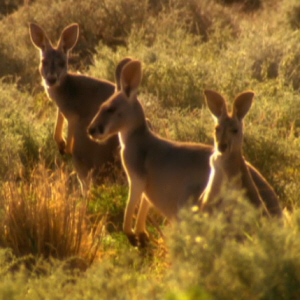
Red Kangaroo
The kangaroos at the most remarkable of mammals because they hop. There is no record, even in the fossil record, of any other large animal that does that
but it makes them very fast and efficient.
When Joseph Banks, who is one of my scientific heroes, first arrived here with captain cook on the Endeavour in 1770, he wrote that "They move so
fast over the rocky, rough ground where they are found, even my greyhound couldn't catch them." I mean, what was he doing with a greyhound?
Kangaroos are herbivorous and scratch out a living feeding on grasses. While foraging, they move in an ungainly fashion, using their large, muscular
tail like a fifth leg. But when they want to, these large marsupials can cover ground at considerable speeds.
To take a leap, kangaroos have to work against the downward pull of Earth's gravity. This takes a lot of energy. As animals go faster, they tend to
use more energy. Not so with the kangaroos.
As the roos to go faster, their energy consumption actually decreases. It then stays constant, even at sustained speeds of up to 40 km/h. This
incredible efficiency for such a large animal comes directly from the kangaroos' anatomy. Kangaroos move so efficiently because they have an ingenious
energy storage mechanism.
See, when something hits the ground after falling from some height, then it has energy that it needs to dissipate. If you're a rock… that energy
is dissipated as sound and a little bit of heat, but if you're a tennis ball… then some of that energy is reused because a tennis ball is elastic,
it can deform, spring back, and use some of that energy to throw itself back into the air again.

Tennis Ball Bounce
Well, a kangaroo is very similar. It has very elastic tendons in its legs, particularly its Achilles tendon and also the tendons in its tail, and
they store energy and then they release it, supplementing the power of the muscles to bounce the kangaroo through the air.
Now, an adult kangaroo is 85, 90 kg, which is heavier than me, and when it's going at full speed, it can jump around 9 metres. That's the distance
from me… to that car. The evolution of the ability to hop gives kangaroos a cheap and efficient way to move around. But not everything can move
like a kangaroo.
The red Kangaroo is the largest animal in the world that moves in this unique way, hopping across the landscape at high speed, and there are reasons
why there aren't giant hopping elephants or dinosaurs, and they're not really biological, it's not down to the details of evolution by natural
selection or environmental pressures. The larger an animal gets, the more severe the restrictions on its body shape and its movements.
To understand why this is the case, I want to explore what happens to the mass of a body when that body increases in size.
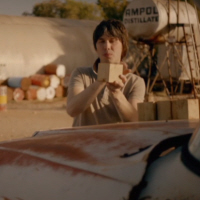
Brian with Wooden Cube
Take a look at this block. Let's say it has width – 1, length – 1, and height 1, then its volume is 1 multiplied by 1 multiplied by 1, which is
one cubic… things, whatever the measurement is. Now, its mass is proportional to the volume, so we could say that the mass of this block is one unit
as well.
Let's say that we're going to double the size of this thing in the sense that we want to double its width, double its length, double its height. Then
its volume is 2 multiplied by 2 multiplied by 2, equals 8 cubic things. Its volume has increased by a factor of 8, and so its mass has increased by a
factor of 8 as well. So although I've only doubled the size of the blocks, I've increased the total mass by 8. As things get bigger, the mass of the
body goes up by the cube of the increase in size. Because of this scaling relationship, the larger you get, the greater the effect. As things get
bigger, the huge increase in mass has a significant impact on the way large animals support themselves against the gravity and how they move about.
No matter how energy-efficient and advantageous it is to hop like a kangaroo, as you get bigger, it's just not physically possible. Going
super-sized on land comes with tremendous constraints attached.
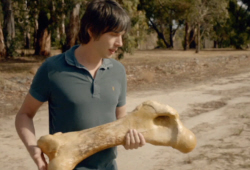
Diprotodon Femur
This is the left femur, the thigh bone of an extinct animal called a Diprotodon, which is the largest known marsupial ever to have existed. This
would have stood as tall as me, it would have been 4 metres long, weighed between 2 and 2 1/2 tons, so the size of a rhino, and it's known that it was
all over Australia, it was the biggest herbivore, and it got progressively bigger over the 25 million years that we have fossils for it, and then
around 50,000 years ago, coincidently, when humans arrived in Australia, the Diprotodon became extinct.
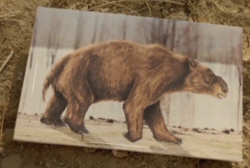
Diprotodon
The Diprotodon is thought to have looked like a giant wombat and being marsupials, the females would have carried their sheep-sized offspring in a
huge pouch. To support their considerable bulk, the Diprotodon skeleton had to be very strong. This imposed significant constraints on the shape and
size of its bones.
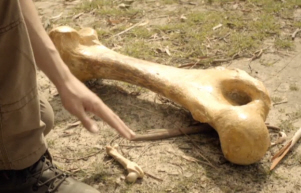
Bone Comparison
This is the femur of the closest living relative of the Diprotodon. it's a wombat, which is an animal around the size of a small dog. And you
see that superficially, the bones are very similar. But let me take a few measurements. The length of the Diprotodon femur is around 75 cm.
The length of the wombat femur is around 15 cm, so this is about 5 times the length of the wombat femur. But now look at the cross-sectional area.
Assuming the bones are roughly circular in cross-section, we can calculate their area using pi multiplied by the radius squared. It turns out
that although the Diprotodon femur is around 5 times longer, it has a cross-sectional area 40 times that of the wombat femur.
A bone's strength depends directly on its cross-sectional area. The Diprotodon needed thick leg bones, braced in a robust skeleton, just to
provide enough strength to support the giant's colossal weight.
As animals get more massive, the effect of gravity plays an increasingly restrictive role in their lives. The shape and form of their body is
forced to change. If you look across the scale of Australian vertebrate life, you see a dramatic difference in bone thickness.
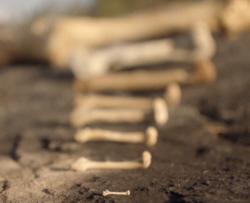
Line of disparate Femurs
This is a line of femur bones of animals of different sizes. We start with the smallest, one of the smallest marsupials in Australia, the
marsupial mouse or the Antechinus. Then the next one is an animal known as the Potoroo. Again, it's a marsupial around about the size of a rabbit.
Then we have the Tasmanian Devil, a wombat, in Dingle, then the largest marsupial in Austrialia today, the red Kangaroo. And this is the femur of
the Diprotodon and then, here, the femur of a Rhoetosaurus, which was a sauropod dinosaur 17 metres long and weighing around 20 tons. And so, you
see, as animals get a larger, from the smallest marsupial mouse, all the way up to a dinosaur, the cross-sectional area of their bones
increases enormously, just to support that increased mass.
Being big and bulky, giants are more restricted as to the shape of their body and how they get about. That's why red Kangaroos are the largest
animals that can move in the way that they do. At a much greater size, their bones would be very heavy, have a greater risk of fracture, and they'd
require far too much energy to move at high speeds. It's ultimately the strength of Earth's gravity that limits the size and the manoeuvrability of
land-based giants. But for the bulk of life on land, gravity is not the defining force of nature.







